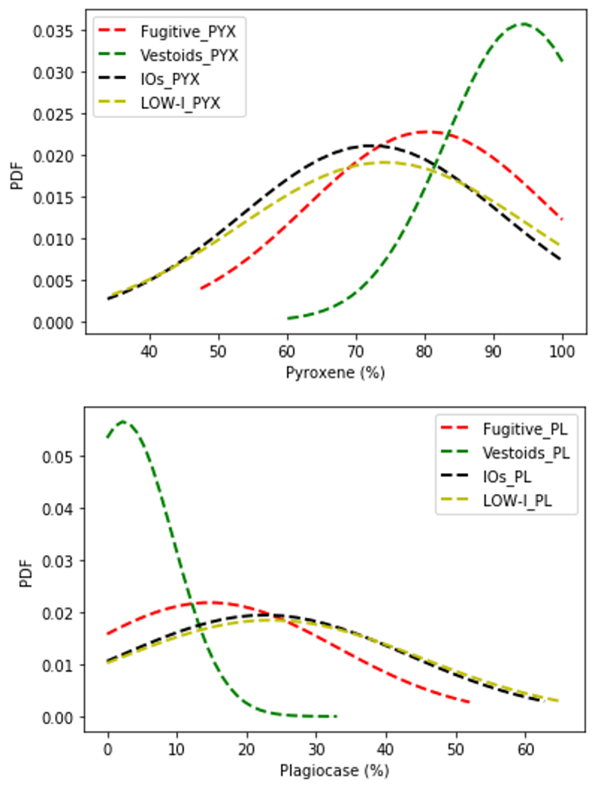Are there significant differences among the mineralogy of V-type asteroids family?
- INAF, IAPS, Italy (marianna.angrisani@inaf.it)
Introduction: V-type asteroids are those whose spectra is similar to Vesta [1].
Vesta underwent two huge impact events [2], that could have formed objects of this taxonomic class [3,4] and have eventually supplied the Vesta meteorites (HEDs) escaped from the Main Belt.
In this work, we look for statistically significant differences among the modal mineralogy of V-type asteroids belonging to different dynamical subclasses through a combination of spectroscopic analysis and Hapke Radiative Transfer Model (RTM).
Data and Methods: 76 Vis-NIR V-type asteroid spectra were downloaded from the Planetary Data System (PDS). In this work, we considered four dynamical families of V-type as follows:
(i) Vestoid: V-type members of the Vesta dynamical family, as defined by [4] using the hierarchical clustering method (HCM).
(ii) Fugitive: following the definition of [4], they are V-type asteroids with a < 2.3 au and comparable e and i with the Vesta family.
(iii) Low-I: according to [4], they are V-type asteroids having i < 6◦ and 2.3 < a < 2.5 au.
(iv) IOs (Inner Others): the remaining V-type asteroids in the inner main belt.
VNIR spectra of Vesta’s, V-type asteroids surface and HED show absorption bands centred at approximately 0.9 and 1.9μm, confirming the pyroxenes presence [5]. Through scatterplot analysis of spectral parameters (in particular, band depth and half width half maximum) of V-type asteroids and of HED, these two bands give evidence of the grain size range of each asteroid. The obtained information is used as constrain in the Hapke’s RTM (to prevent possible degeneration in the creation of synthetic spectra) to retrieve modal composition for each V-type asteroid. To simulate asteroids spectra in the Hapke RTM, we used the main endmembers of HED and we also added a darkening agent (Murchison spectrum) to find possible correlations between V-type asteroids and dark regions on Vesta [6].
Spectral fits of the asteroid’s dataset are robust with a global R mean square of 0.98, while the retrieved particle sizes are small with a mean value of 20 µm.
Results and Discussion: Comparing the modal mineralogy obtained from Hapke RTM and the [7] studies, it is possible to assign a lithology to each dynamical subclass. In particular, we can distinguish diogenites (approximately 100 % of pyroxene), noritic diogenites (2-42 % plagioclase, 52-97 pyroxene), cumulate eucrite (30-64 % plagioclase and 36-70 % pyroxene) and basaltic eucrite (39-46% plagioclase, 46-60 % pyroxene).
Then, in Figure 1, we report the mean and the standard deviation of sample of the four subclasses (Fugitive, Vestoids, Inner Others and Low-i). It seems that Vestoids and Fugitive are diogenitic (diogenitic and noritic diogenites respectively), while Low-I and Inner Other (IOs) are eucritic (Figure 2).
Figure 1: Results of mean mineralogy for each subclass from Hapke retrival

Figure 2: Probability density function of Pyroxene (up) and of Plagioclase (bottom) for each subclass
The most ‘ancient’ family, that is Low-i asteroids (they may date back to the LHB epoch or even to the 4.48-Ga impact on Vesta), seems to have an eucritic composition. In the most recent models of the structure of Vesta, it has a massive eucritic crust. Moreover, [2] found that the density of craters increases from the Rheasilvia rim to northern latitudes. This dichotomy in terms of crater density indicates that heavily cratered terrains (centered at about 348°E, 17°N and 110°E, 17°N) are much older than Rheasilvia basin, whose most probable age is estimated to be 1.0 ± 0.2 Ga [2]. Thus, it is compatible with the mineralogy of the Low-I asteroids that ‘swept out’, in the past, the outermost layer of Vesta.
Fugitive better match with a diogenitic composition. For this subclass, the probable age of formation is at least 1 Ga so that they could migrate away from Vesta [4], then it is possible that they were ejected in an older (2 Ga) cratering event that produced the Veneneia basin that underlies Rheasilvia [8].
Furthermore, [9] found from Dawn data that Rheasilvia basin (probable age is estimated to be 1.0 ± 0.2 Ga [9]) is consistent with a larger abundance of diogenite on the surface, while spectra from the equatorial regions are consistent with a larger eucrite amount. Thus, there is a possible chronologic link between impact events on Rheasilvia crater and the Vestoids, which, from our work, have a mineralogy associated to Diogenites.
In any family, there is no signature of dark material as carbonaceous chondrites (here we used Murchison spectra to simulate it). This could be explained by the fact that it has an exogenous origin [6,10], and it could have impacted on Vesta after the V-type family formation.
From this work, a possible chronologic link between impact events on Vesta and the V-type family is possible. We plan to augment the database of V-type asteroids to improve the statistical analysis.
References: [1] De Meo,F. E. et al. (2009), Icarus, n. 202,p.160–180; [2] Marchi, S. et al. (2012), SCIENCE, Vol 336, Issue 6082, pp. 690-694; [3] Carruba, V. et al. (2007), A&A 465, 315-330;[4] Nesvorny, D. et al. (2008), Icarus, vol 183, 85–95; [5] De Sanctis,M.C. et al. (2013), Meteorit. Planet. Sci, vol. 48, n. 11, p. 2166–2184; [6] Palomba,E et al. (2014), Ica-rus, n. 240, pp. 58-72; [7] Mittlefehldt,D.W. et al. (2015), Chemie der Erde, vol. 75, pp. 155-183 ; [8] McSween, H.Y.J. et al. (2013), Meteorit. Planet. Sci, vol. 48, n. 11, p. 2090–2104; [9] De Sanctis, M.C. et al. (2012), SCIENCE ,VOL 336; [10] Turrini, D. et al. (2014), Icarus, 240, 86-102
How to cite: Angrisani, M., Palomba, E., Longobardo, A., Raponi, A., Gisellu, C., and Dirri, F.: Are there significant differences among the mineralogy of V-type asteroids family? , Europlanet Science Congress 2022, Granada, Spain, 18–23 Sep 2022, EPSC2022-270, https://doi.org/10.5194/epsc2022-270, 2022.

